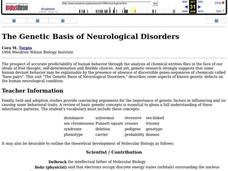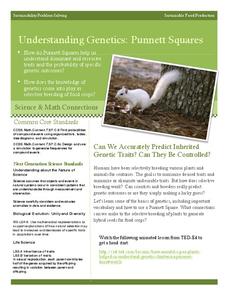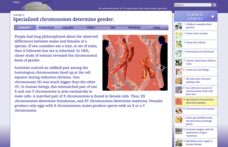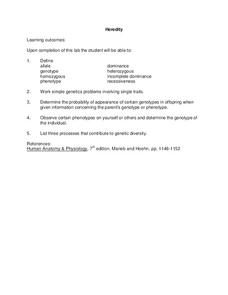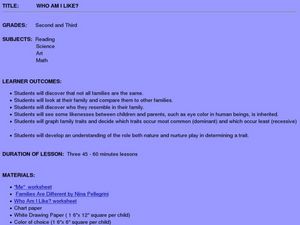Curated OER
Who am I and Why?
Students make comparisons about themselves and others, which are real and meaningful. They study some basic concepts in the area of genetics and do a complimentary series of experiments, or explorations that illustrate these concepts
Curated OER
Biology Wordsearch
In this biology activity, students identify and locate various vocabulary terms found in a biology lesson. There are 39 biology terms located in the word search.
Curated OER
Freshmen Biology Terms
In this biology worksheet, 9th graders identify and locate various vocabulary terms pertaining to ninth grade biology. There are 48 biology terms located in the word search.
Curated OER
Nature And Nurture
Students develop an understanding of the role both nature and nurture play in determining an individual's traits. Using a website, students answer questions about nature and nurture in order to solve the riddle, What do you call a smart...
Curated OER
The Genetic Basis of Neurological Disorders
Students explore neurological disorders. They examine the presence and absence of discernible genes. Students describe neruological diseases and draw faces of affected persons. They play a human neurology disorders learning game.
Curated OER
Bringing the Rain to Kapiti Plain
Students identify the African Plains and the plants and animals that are found on the plain, which are of a benefit to humans. They listen to the story and actively participate in a choral reading of Bringing the Rain to Kapiti Plain.
Curated OER
A Look Into the Past
Students practice looking at their genetics to inquire about their past. In groups, they determine their recessive and dominant genes and plot their height on a graph. They compare and contrast the processes of meiosis and mitosis. ...
Curated OER
The Genetic Basis of Neurological Disorders
Young scholars describe some aspects of known genetic defects on the human neurological condition. They participate in a variety of exercises including drawings, games, and analogies.
Curated OER
Natural Selection in Protected And Unprotected Populations
Studnets compare how two elephant seal populations fare during successive generations. They participate in a simulation using a card game to look at the differences in two populations, one that is protected from mortality by human...
WK Kellogg Biological Station
Sounds of Selection
Do you want a creative and fun way to teach about natural selection? Hop to it by turning your middle school princes and princesses into frogs trying to catch as many bugs as possible in a Hungry Hungry Hippos style game. For high...
Agriculture in the Classroom
A Rafter of Turkeys
How did that turkey get from the early Aztec culture to your table? Learn about the history of wild and domesticated turkeys in North America, as well as their inclusion in Thanksgiving traditions, with a two-part agricultural science...
Curated OER
Adaptation Worksheet
Adaptation or acclimation? Young ecologists determine which is being exemplified in twenty questions. When teaching about adaptations, make sure to talk about acclimation, a short-term learned response to a change in the surroundings....
Curated OER
Mendelian and Non-Mendelian Heredity
Tenth graders discuss their physical features, and why they look the way they do. They listen as the teacher discusses DNA, alleles, and dominant or recessive genes. Students perform an experiment with different colored markers...
Curated OER
Sibling Relationships in the Animal World
Students research sibling relationships in the animal world. In this animal science instructional activity, students read the book, Sisters and Brothers: Sibling Relationships in the Animal World and discuss the sibling relationships....
Western Kentucky University
Understanding Genetics: Punnett Squares
Can scientists really predict genetic outcomes or are they simply making a lucky guess? Scholars first learn about Gregor Mendel and how to make Punnett squares. Then they extract DNA from a strawberry in a lab with included conclusion...
Curated OER
Recombination and Pedigrees
Biology aces answer four questions about genetic recombination and nine questions about pedigrees. This worksheet is very focused on these two topics. Most of the pedigree questions relate to the genetic disorders, Alkaptonuria and...
National Center for Case Study Teaching in Science
In Sickness and in Health
Based on family history, how likely is it that a couple's children will have a recessive disease? In an in-depth, but easy-to-follow case study, future geneticists learn the story of Greg and Olga, who are hoping to have children, but...
Personal Genetics Education Project
How Does Ancestry Testing Work? Exploring Admixture Testing
Find out the science behind ancestry testing! Investigators watch a video exploring how ancestry works before participating in a hands-on group activity. Scholars role play scientists while learning about testing protocols and test...
Cold Spring Harbor Laboratory
Specialized Chromosomes Determine Gender
Are you an XX or an XY? Budding scientists learn about cellular fertilization and the determination of gender in a thorough online lesson. They follow their study with a set of interactive reflection questions.
Curated OER
Where Are the Dinosaurs?
Students explore the concept of extinction by studying dinosaurs. In this dinosaur lesson plan, students distinguish between extinct creatures and those that still exist.
Curated OER
Evolution Number Two
Are you looking for evidence that your high schoolers are adapting to the concepts of natural selection and evolution? Assess their knowledge with a pretest and posttest. Naturally, you can select and adapt the worksheet to be the...
Curated OER
Where are the Dinosaurs?
Students construct their own diorama based on the life of a dinosaur. In this dinosaur lesson, students create models of dinosaurs and dinosaurs' eggs to explore the life cycle of this extinct species.
Curated OER
Heredity
In this science worksheet, students find the answers to various types of heredity problems. They use the sheet to set goals for completing the unit.
Curated OER
Who Am I Like?
Students examine family structures. In this family structure lesson, students discover things about their own families and those of their classmates. They make a chart as they discuss nature versus nurture, complete a worksheet about who...






